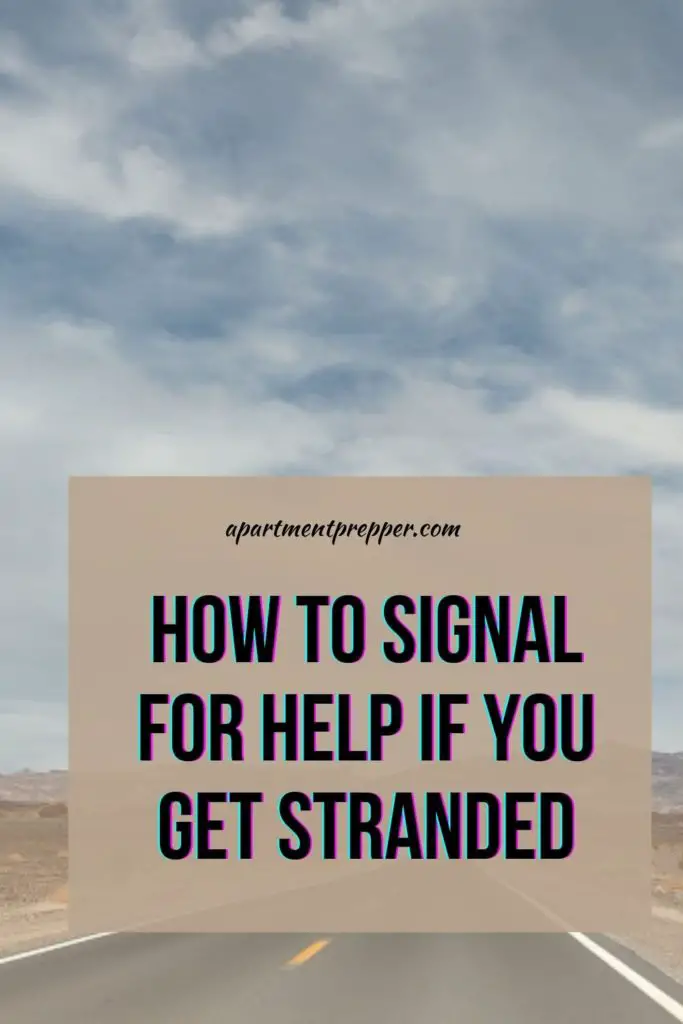Written by Bernie Carr
Travel season is coming up and thousands of people will take to the roads for their vacation. With long distance travel and the desire to be out in nature, some people may lose their way or become stranded in an isolated area.
If you end up lost in the wilderness, it is important to know various techniques to help rescue personnel find you. That’s why knowing what signals to use is important. Don’t rely on just one method to signal for help – learn multiple ways and use a combination of methods to get yourself found as quickly as possible. Learning ways to signal may not sound like the most exciting thing but it may one day save your life.
Your car
If you are stranded by the side of the road with a vehicle that has broken down, one of the easiest ways to communicate that you need assistance is to lift up the hood as well as the trunk of your car. You can also attach a red piece of cloth to your antenna to indicate that you need help.
Get someone to hear you
One way to attract the attention of rescuers is by using noise. In a rescue situation, any sound that comes in threes is universally recognized as a call for help.
Whistle
A simple whistle is often skipped or neglected as a survival tool. But they can come in handy in an emergency, as in the case of getting lost. Whistles can usually be heard up to a mile away, depending on the area. If you do not have a whistle, you can try whistling yourself but the human whistle sound does not carry as far.
Firearm
Gunshots can be heard for several miles and can be used as a signal for help. You will need to decide for yourself according to your situation if you can spare the ammo, or if you’d rather use it for hunting or defense.
Noise making objects
You can use anything you have or happen to find in nature that makes a loud sound. Bang on pots and pans, use a large stick to pound on a hollow log or hit two rocks against each other.
Use whatever you have and make the sound three times within spaced intervals. After a couple of minutes, start the pattern again.
Your surroundings and weather conditions make a difference on how far sounds can be heard. Heavy winds, rain, ridges in the surrounding terrain may prevent the sound from carrying as far.
Get seen
Another way to get rescuers to find you is by sending out visual signals. Here are some tips to remember:
Color contrast
Raise a red flag, cloth, shirt or anything that will contrast with your surroundings. A color that is completely different from the color of your surroundings is more likely to get attention.
Height
To maximize your chances of being located, find a clear flat area, ideally at a the highest elevation you can manage such as a hill.
Nature contains very few straight lines, therefore, using straight lines in your signals will more likely attract the attention of rescuers in the area.
Signal size
The larger the size or your signal, the more likely it will be spotted.
Daytime Signaling
Smoke
During the day, smoke is much more likely to get attention than fire. Three columns of smoke is the international signal for distress.
Using contrast will increase the likelihood that your signal will be spotted. If your background is dark, try to create white smoke. White smoke is made by smothering a fire with green (not dried) leaves, grass, moss or by sprinkling water on it. Dark smoke is produced by adding rubber, plastic or oily materials to the fire.
Smoke signals are effective during clear days when the weather is calm. Strong winds, rain or snow would tend to spread the smoke.
Mirror
The signal mirror is a time-tested method to send information across a distance. On a sunny day, a mirror’s reflection can be spotted as far as 50 miles across land, air or sea.
Signal mirrors have a sighting hole in the middle that can help you aim.
You can also use other shiny objects such as aluminum foil, belt buckle, or soda can to reflect sunlight. Using reflection has been known to be very effective in attracting attention: In 1991, some plane crash survivors floating in life vests in the Bahamas used shiny credit cards to reflect sunlight at a plane. They managed to get rescued.
Flash the light toward your target area using the universal SOS pattern: three short flashes, three long flashes, three short flashes.
Avoid directing the beam of light toward an airplane pilot or a driver’s front windshield as it can momentarily blind someone and potentially cause an accident.
Night Signaling
Flashlight
A flashlight is another excellent survival tool that can be used for signaling. As soon as it’s dark, use a flashlight to send an SOS in Morse code: flash the light in three short flashes, three long flashes and three short flashes in the direction of possible rescuers. As an alternative, you can also use the strobe light function of your flashlight to garner attention.
Signal Fire
Using signal fires are a great way to signal when it’s dark. However, there are precautions to be taken before you start building the fires.
If you are in a heavily wooded area, tall trees will prevent the fires from being spotted from above. Find an open area or clear an area (around 15 feet). If you have no clearing, build an earth wall around the fire to keep it from spreading.
If at all possible, the general recommendation is to build three fires all at once, around 80 feet apart. Be ready to light all three as soon as you hear a plane flying overhead. However, if you are alone and unable to manage three fires due to lack of energy or resources, then concentrate on building one signal fire. Have your firestarter, kindling, and firewood ready to light as soon as you hear any sign to rescuers in the area.
Additional tips
Don’t rely on GPS to get around, keep paper maps with you. Let someone know your route and destination, notify them when you are expected to arrive so they can call for help if they don’t hear from you. Before embarking on any trips make sure you have well-stocked car survival kit and always prep your car in case of emergencies. Getting lost is never in anyone’s plan, but if you know a few ways to signal for help, you will increase your chances of getting rescued as quickly as possible in case you ever get stranded. Safe travels!



2 comments